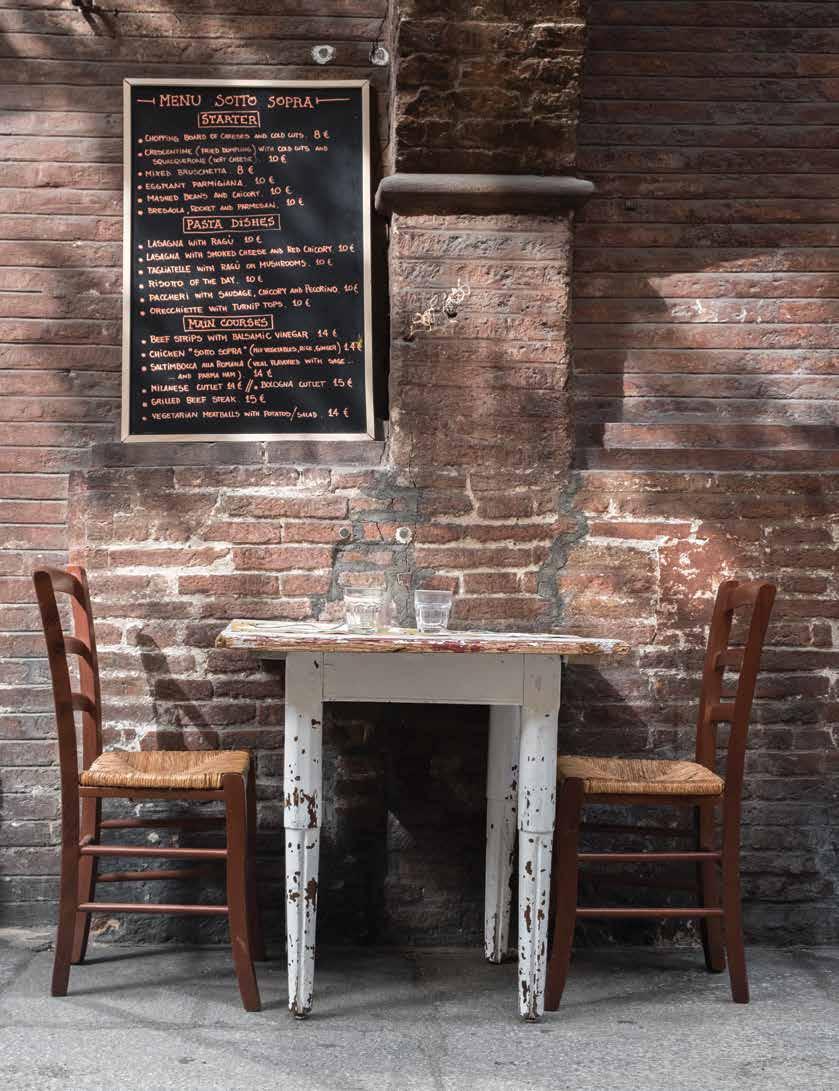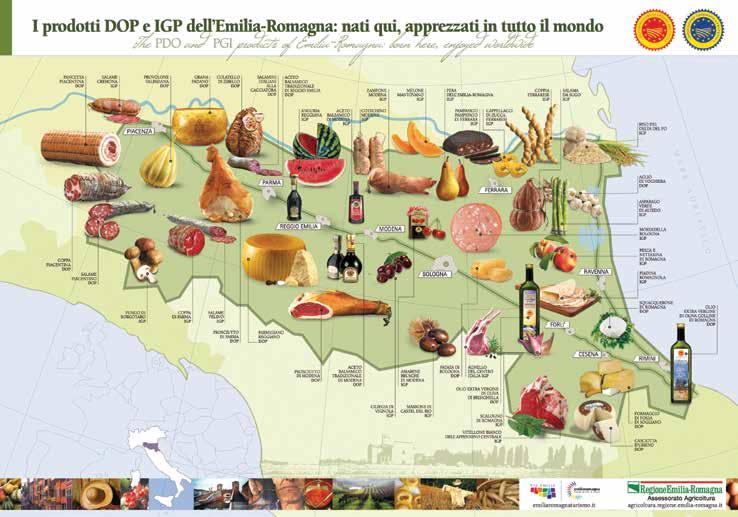
5 minute read
A FoodTour of Emilia Romagna
A FOOD TOUR OF Emilia-Romagna
BY MICHELE JACOBSON
Advertisement
Like a string of pearls across the verdant landscape of Emilia-Romagna lie the gastronomic gems of Parma, Modena, Reggio-Emilia, and Bologna. I was told the best food in Italy was here and I was not disappointed. The famed Italian cucina povera, which relies on meager ingredients to create spectacular results, is non-existent here. This is a wealthy region, rich in both its appetites and the arts. Bologna, the capital, ranks for highest quality of life in Italy, no small achievement in a land where la dolce vita is a national pastime. Emilia-Romagna is home to some of the worlds’ most famous foods, including Prosciutto di Parma ham, Parmigiano Reggiano cheese, and Aceto Balsamico di Modena, the iconic vinegar of Modena. These, and many other, products are regulated by Italian consortiums, which label them to ensure authenticity and quality. Methods and ingredients are strictly controlled; indeed, even the type of grass livestock eats is controlled for its milk or meat to be used as an ingredient. Understanding labels can help consumers appreciate Italian dedication to tradition, as well as the price of many products. Of the approximately 200 certified Italian products, more than 40 are produced in Emilia-Romagna. (see box) Parma Shops along the cobbled streets prominently display rosy Prosciutto di Parma and wheels of Parmigiano-Reggiano like souvenirs. Fanned out on a tagliere (cutting board), these can make a meal, but do not miss the Piatti della Tradizione (traditional dishes) that Parma does best, such Agnoli en brodo (ravioli in broth), and Tortelli d’erbetta. This fresh egg pasta is filled with breadcrumbs, chard, cheese and nutmeg, as per Parma tradition, a departure from the meat version served in Piacenza, an hour away. This variation demonstrates the hyper-regionality of true Italian cuisine. Prosciutto di Parma PDO is widely regarded as one of the worlds’ best hams, and is recognized by the Parma crown on its label. It is simply produced from the hind leg of certain heritage pig breeds, with only a small amount of Mediterranean sea salt. Air-cured in the distinct clime of the Parma region, this meat is not brined or smoked, nor does it contain additives or other preservatives. Prosciutto di Parma cannot be compared with processed cold cuts, like those made in the United States. Other famed pork products from this region include Culatello di Zibello, made from the loin, and Spalla di San Secondo, from the shoulder. Strict guidelines must be followed to obtain PDO status. For example, Culatello di Zibello is aged in the bladder of a hog or cow. (Strange food fact, but true.) Parmigiano-Reggiano PDO is big business; annually, 18 percent of Italy’s milk is used to produce more than 3.6 million cheese wheels. It is made, in accordance with age-old tradition, from the unpasteurized morning milk of grass-fed cows, which is mixed with skimmed milk from the previous evening. The only other ingredient is Mediterranean sea salt. According to Italian law, production is limited to specific locales in Emilia-Romagna and Mantua, Lombardy. Parmigiano-Reggiano should not be confused with generic parmesan cheese which often masquerades as its equivalent, especially in the United States. Generic brands contain additives, such as non-dairy and anti-caking agents, and at least one brand has been brought to court for containing no parmigiana-type cheese at all. The authenticity of true ParmigianoReggiano PDO is indicated by markings on its rind, as regulated by the consortium. It is a A Food Tour of Emilia-Romagna singular joy to order a cocktail in Emilia-Romagna, and receive alongside a plate heaped with

chiseled chunks of Parmigiano-Reggiano. Modena Due east from Parma is Modena, home to Prosciutto di Modena, Aceto Balsamico di Modena, and a host of distinctive stuffed pastas. The Modena name is on some of the worlds most famous foods. Prosciutto di Modena PDO is made with meat from certain pig breeds, then aged at specific altitudes, for a longer time than its counterpart in Parma. It is served raw, or crudo, as opposed to cooked, cotto, and can be recognized by the Pm fire-brand on its label. Modena is also where the iconic Aceto Balsamico di Modena is produced. Bittersweet and balanced, this renowned condiment can enhance salads, cheeses, meats and fruit. In fact, simply calling it vinegar is akin to describing Ragù as mere spaghetti sauce. As per ancient Roman methods, Aceto Balsamico is made from the fermented must (the juice and crushed seeds, stems and skin) of specific grapes, primarily the Trebbiano variety. Aged in wooden barrels for a minimum of 12 years for Aceto Balsamico Tradizionale di Modena Affinato PDO, to at least 25 for Aceto Balsamico Tradizionale di Modena Extra Vecchio PDO (extra old). There is also a PGI balsamic Invecchiato (aged) which abides by less-stringent regulations, requiring only 3 years of aging. Strict packaging requirement must be followed, assuring type and proof of origin. Balsamic Vinegar of Modena (BVM) is an inexpensive imitation of Traditional Balsamic Vinegar (TBV). In Italy, acronyms count for a lot. Modena’s contribution to Italian pasta is the trilogy of tortelli, tortelloni and tortellini. The different names refer to decreasing sizes of this stuffed, half-moon shaped pasta. Tortellini (the smallest) is generally served en brodo, in broth, drizzled with Aceto Balsamico and sprinkled with Parmigiana Reggiano. Adventurous and acclaimed, three Michelin star Osteria Francescana can also be found in Modena. It has repeatedly been named one of the worlds’ best restaurants. While this is no small feat, remember this is Italy, and you also really can’t go wrong at the corner trattoria. Bologna Italy offers amazing sites from Matera to Milan, but if it’s the best food you seek, an Italian will steer you to Bologna. The historic capital of Emilia Romagna is both ancient and modern; a place where you wend your way down endless colonnaded sidewalks, amongst tables set for dining al fresco. Food is everywhere. The cuisine here is traditional; should you order Ragù Bolognese with spaghetti you may risk tussling with a butcher knife-wielding chef. (My husband repeatedly made this rookie mistake). Instead, the long ribbons of fresh egg pasta, tagliatelle, are perfect for holding the classic ragù, a hearty sauce of minced meat, soffrito and tomato sauce. It is the signature dish of Bologna, and there is no messing with perfection. Another specialty is Mortadella di Bologna, a distinctive sausage traditionally






